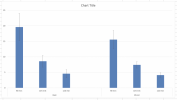DopeyBadger
Imagathoner
- Joined
- Oct 15, 2015
- Messages
- 10,369
That is one relevant GIF...
For sure!
That is one relevant GIF...




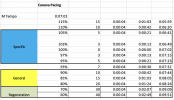
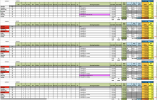
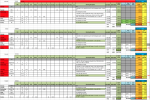
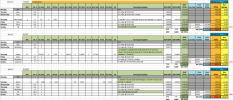
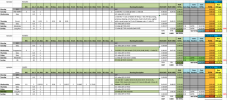
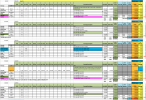
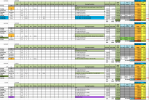

Looks challenging! I'm looking forward to following along with your progress and seeing what you learn.Madison Marathon 2022 Training Plan - Canova Marathon Plan
Alright, so I decided to sit down and write the Madison Marathon training plan out. I'm 25 weeks out now, and starting to get to a point where I'd need to make some decisions on which methodology I'd like to follow. To change things up a bit, I've decided I will follow the Canova style marathon training plan. I've previously detailed some of the key aspects and source material (link), but will be going into how I made the decisions I did on the types of workouts for this plan. So let's dive into the plan as it is written today.
Pacing
I'm basing the pacing of this plan off of my 2018 10k PR of 39:54, 2019 HM PR of 1:28:40, and 2020 Mile PR of 5:42. I feel comfortable saying that these are still achievable times for me.
View attachment 671233
Canova uses a % of Marathon Tempo method for determining pacing. His calculation for % M Tempo is not how I would have intuitively calculated it. Take the min/mile M Tempo and divide by 100. That's the number of seconds per 1% difference from 100%. So my 103% is 3*(roughly 4 sec) = 13 seconds. 7:02-13 seconds = 6:49 pace.
So if you see me scheduled for 8:26 pace, then that's me doing 80% M Tempo pace. Like Hansons, Daniels, and some others, Canova follows the idea of duration * effort as being the main driver. So you doing 80% M Tempo for 120 min is roughly the same as me doing 80% M Tempo for 120 min. Regardless of our two paces.
One thing to keep in mind with the pacing per Canova, it's ok to make adjustments on the pace based on the temps and hills during the Intro, General, and Fundamental Phase. So similar to what I normally do. But Canova says that during the Specific Phase the paces scheduled are solid (more specifically on the hard days). Canova says that you can move the workout to a different day, or different time of day but you can't change the pace of the workout. If you can't move the workout, then you do the workout at the scheduled pace until you can't. So instead of doing 10 miles at a slightly slower pace, you do 8 miles at the right pace until you can't. So that's a little bit of a difference from what I've done in the recent past when it comes to pace adjustments. Thankfully, the Specific Phase for this particular training plan doesn't occur until September/October when the temps start to calm down.
Introduction Phase
The introduction phase is typically the period of time after the last marathon for a few weeks. But since I was stuck in a no man's land in terms of time between when I was ready to resume training post-Princess, and the start of the Madison M, I just decided to extend this phase of the plan. The goal here was exclusively easy running, nothing longer than an hour, and to hit the gym. The gym workouts were focused on HIIT, plyometrics, and developing some strength/resistance in the legs. So I lined up this phase of training with LIIFT4 workouts from Beachbody. Unlike previous training plans when I was in the midst of hard running workouts, this time around my running is almost all easy during this phase. Which means I can do the full LIIFT4 workouts without any modifications. Normally during the midst of a training plan with hard runs, I wouldn't do the HIIT portion of the LIIFT4 workouts, and I wouldn't do any of the "Legs" workouts. My introductory phase is going to last 10 weeks in total, with eight weeks of LIIFT4 workouts inside that period of time.
View attachment 671234
Since I'm running six days per week at no more than one hour per day, that puts me at about six hours per week of running. Lifting wise I'm at about 2-2.5 hours. With three weeks remaining before the "General" phase begins, I'll add in some strides at the end of two easy runs per week. With strides being about 10-15 sec in duration, a general pick-up of pace, not max speed, on flat road, sufficient recovery between reps to feel fully rested, and limiting them to about 5-6 reps total.
General Phase
View attachment 671235
The general will last four weeks. The overarching goal of this phase is to start to run longer than an hour each day, and bridge the differences between the intro phase and the fundamental phase. Everything you do as you progress through the training plan is specifically to prepare you for future workouts and ultimately for the rigors of the specifics of running a marathon.
One thing you'll notice about the training plan is touches from the previous phase reappearing in the next phase. So those three weeks of strides at the end of the Intro phase will lead into 15 sec uphill max speed sprints. Canova wants us to work on absolute max speed sprints on an uphill to recruit seldom used portions of the leg muscles that endurance runners tend to ignore. He has us do the sprints uphill to lessen the force impact of the workout. During the uphill sprints, there is a long period of rest before the next rep (2-3 minutes). The goal is to feel fully rested and prepared before doing the next rep. This type of workout is "quality over quantity". So while I have 10 reps scheduled, the real number of reps I'll do on that day is dictated by how the workout is going. If I feel the quality of the workout is falling after 6 reps, then the workout is done. If I feel good after 10 reps, then see how 11 feels. There is no "gutting it out" or "pushing through" on this type of workout. It serves a very specific purpose, and that purpose is done when the quality is done. Canova sees this uphill sprint workout as a replacement for the gym leg workout, and a more specific to running type of strength building. You're unlikely to make dramatic gains with this workout over a period of several weeks, but rather it's just something he wants us to revisit every once in a while to remind the body.
Along the same path of the strides leading to uphill sprint workouts, the HIIT in the LIIFT4 is leading into the "Circuit" workouts. Instead of doing lifting routines intermittently with the HIIT workout, now I'll be doing reps of 400m at M Tempo. So 400m M Tempo, then 30s of jumping, then 400m M Tempo, then squat jumps, etc. The idea being you're just trying to bring in muscle groups that you don't normally stress as much during the run, during a running exercise. And because the 30s HIIT moves should be somewhat similar to what you had been doing in the previous phase during your gym workouts, what this is doing is allowing you to build some time at your goal running pace. Canova recommends doing about 2400m of 400m M Tempo per rep set, and 5-6 min of rest between sets. Start at three sets and work your way up to seven sets at the most. I'm aiming for three, and then I'll see how it goes. HIIT has never been a strength for me compared to just straight running.
There are three other workout types you'll see just in the first week of the general phase. You've got your standard easy day (Canova refers to them as "regeneration") which is done at 60-70% M Tempo (so 9:09-9:51 min/mile for me). According to Canova's data, these act as active recovery workouts. He has data to show that someone's lactate levels pre-workout are higher than post-workout if the workout is done appropriately slow enough. That's to say, having done the easy workout itself is actually more advantageous to speeding up recovery than it would be to take a day completely off. This concept is not foreign to me. So I'll be mindful of being slow enough on these days. The second workout is called a "moderate run" which is done around 85% M Tempo (8:05 min/mile for me). This appear to be very similar to Hansons EB pace (a slightly quicker easy pace, but not quite a full blown long run Hansons pace). Similar to Hansons, Canova puts the duration of these in the 60-90 min range on a consistent basis. Lastly, is the long run. The goal during the General phase is mostly "time on feet". So his general phase long run pace is slower than both Daniels and Hansons in that regard. He's more concerned with just getting a good distance in. So where I would have been doing about 7:44 min/mile pace for my long runs, Canova is asking for 80% M Tempo (or 8:26 min/mile for me) during this initial period. You'll see that this is actually slower than the "moderate" runs. Since the pace is so much slower, I feel I'll be handle what appears to be a large increase in duration starting off with 14 miles (120 min). The ultimate goal with these long runs is to get up close to something around the time you plan on running the marathon in, but only for the purpose in preparing your body for the very demanding workouts found in the "specific phase". So Canova agrees with Hansons and Daniels in the respect that long runs should be limited in duration and quicker towards the end of the plan, but disagrees about the need for a longer long run based on duration with a very slow pace earlier in the plan. Where others view the potentially extra long run as detrimental (or the gains don't justify the damage), Canova thinks that these extra long runs don't support the marathon performance itself, but rather the demanding workouts that come towards the end of the training plan. Canova cares more about specificity to the marathon pace, than he does a certain distance or duration of a long run at the end of training. In the youtube video I linked earlier, he goes into a short discussion about the methodology of training in Asia with massive amounts of distance training. As much as 400km per month (250 miles) with long runs as much as 100km (62 miles) in training for the marathon. Yet in Canova's opinion, they've created very few champions and tons and tons of burnout after two years of individual work. So he's more of a proponent of specificity than he is of some set distance/duration goal for the long run when it comes to the end of the training. So like Hansons and Daniels the long run at the end of training is limited in duration, and relatively quick.
Another thing that will be noticeable during the general phase is the dropping of the strength workouts from four days per week to two days per week. I'll continue to recycle the LIIFT4 workouts, but I'll drop the HIIT portions, and the "shoulders" and "legs" workouts completely. The goal is to continue some strength, but not nearly to the same level as during the intro phase. The uphill sprints replace the need for the legs workout, and the circuit workouts replaces the need for HIIT.
As the remainder of the general phase continues, I'll introduce three other types of workouts. A LR/MT alternating workout, a Mona fartlek like workout, and a progression workout. The LR/MT workout's purpose is to continue to extend the amount of time you run at M Tempo, but keeping the workout relatively easy with the intermixing of the general phase LR pace (80% M Tempo). As the plan progresses, the goal is to be running at M Tempo for longer periods of time, and the "resting" pace that is used gets quicker. So it starts at 80% M Tempo, and towards the end it gets as fast as 97% M Tempo. The Mona fartlek is a way to incorporate the uphill sprint workouts into a M Tempo based workout. So a little M Tempo, and then a few sprints, and then repeat. The progression is pretty self-explanatory, but early on progresses from 80%->100% over the course of 40 min.
At the conclusion of the general phase, you'll have introduced M Tempo, begun to increase the duration of the long run (albeit at a slower pace), and gotten reasonably close to max mileage for the plan. So this is where I personally diverge quite a bit from Canova plans compared to my previous plans. More often than not, my max weekly mileage doesn't come until late in the plan. I'm usually limited by the number of weeks I can maintain a higher volume of work before I start to see my fitness fade based on my personal data. But there's reason to believe that it's a combination of the very tough workouts and maintaining that mileage that could have been the limiting factor for me in the past. So since these workouts in the earlier phases of Canova would be what I would personally consider on the easier side, it's entirely possible that peaking in volume a little earlier may be alright for me since the intensity is pulled back more. I liken the design of this plan to most similarly match my Lakefront 2016 and 2017s plan where I essentially hit peak mileage at 13 weeks out from race day and maintained. Albeit, the intensity of this Canova plan will build more intently over the course of the plan. It remains to be seen whether this type of training will mesh with my characteristics.
Fundamental Phase
View attachment 671252
View attachment 671253
Alright, with 16 weeks to go until race day, we enter the six week long "Fundamental Phase". We start to move a little more away from the HIIT workouts and the uphill sprints, and start to pull even more on tightening the window of paces around goal M Tempo. The idea here is that as the plan progresses we're getting more and more marathon specific. So the fast paces are getting longer and slower, and the slow paces are getting shorter and faster. In some respects, this is not dissimilar from my training in the past. As the plan progresses, the paces should converge around M Tempo. I think Canova would be a fan of Hansons in some respects (M Strength intervals and M Tempo workouts of 6-10 miles continuous), but in some respects Canova diverges in that he wants the workouts harder, and the recovery between workouts longer (3-4 days between really hard bouts). So in some respects the Canova workouts are sort of like a hybrid between Daniels super hard workouts, and the specificity of Hansons.
As the uphill sprints start to fall off the plan, strides are peppered in to continue their purpose. Where we were scheduled for 10, now we'll probably only do a few uphill strides just to keep re-reminding the body. The Mona and Circuit workouts will each make a brief appearance as well.
The general phase long run (80% M Tempo) will continue to increase during the fundamental phase going from 2:30 hrs to 2:50 hrs. The goal here is to be low and slow. These are focused on duration and not a hard pace. In fact, we don't want these to be a hard pace to overall keep them easy. Even when I hit 20 miles (2:50 hrs) at the max with 12 weeks to go until race day, it still only represents 33% of the weekly mileage at 61.5 miles. So the volume of the long run is up, but it doesn't encompass a large portion of the overall mileage.
Alongside the increasing general phase long run (80% M Tempo) you can see the fundamental phase long run (90% M Tempo or 7:44 min/mile) also increasing. Not nearly at the same duration as the general phase LR workouts. The goal here is to start to get some workouts in closer and closer to M Tempo, but keeping the duration of these on the lower end as to not need a massive amount of recovery from them. Where my previous training plans would have seen me do 2:10-2:30 hrs at 7:30-7:44, in this Canova plan, the duration of paces in the 7:20-7:40 range is going to be under 120 min. And based on my past experience and data, I think that's where I've gotten myself into trouble. My long runs are fast, and I see a negative response to my overall training progression when these workouts get too long. I can do them comfortably, and I feel fine doing them, but there's just something about them that seems to mark a downward trend in fitness. Regardless, these 90% M Tempo long runs will start to increase in duration alongside the 80% M Tempo runs to better prepare me for the "specific phase". The plan will peak in duration exercise at the end of the Fundamental phase a full 12 weeks before the race occurring.
The Progression workout goes from (80% M Tempo -> 100% M Tempo) to (100% M Tempo -> 106% M Tempo). So a harder version of the same workout.
There's the introduction of HM Tempo pacing held at a continuous pace as well. Nothing special there.
Lastly, a Ladder workout that changes the duration of the workout as the paces change. The faster the shorter, and the slower the longer. The goal is to touch paces all around M Tempo.
The goal of the end of the Fundamental phase is to be capable of doing the challenging workouts that occur during the Specific Phase.
Specific Phase
View attachment 671254
Now we're in the meat of the training. Things get ratcheted up another notch. Having flexibility in my personal/work life is what is going to make this possible. Because the plan doesn't follow a normal sequence with a set hard day every week. Rather the eye is being kept on the number of days in-between hard workouts to make sure there's an appropriate level of recovery. So where I would have normally done 1-2 days between hard workouts, now I'll be doing 3-5 days between. But make no mistake, the additional recovery is because these workouts are tough. Additionally, some of these workouts are going to demand >90 min on a weekday. So in those cases I'll plan on taking the day off from work when possible.
LIIFT4 will continue as it did during the Fundamental phase. Only on Sat/Sun, and only the arm/back lifting workouts. No HIIT and no shoulders/legs.
The first new workout is the M Alt workout. In each set there's 12 min M Tempo + 3 min 95% + 3 min 110% + 1km at 70%. The average pace during those sets including the 70% pace is 7:23 min/mile which comes out to the 95% pace. So I'm doing like 90 min of 7:23 pace broken up into intervals. That's a fairly tough workout.
The next workout is 14 miles (100 min) at M Tempo. That's tougher than any M Tempo workout that I can remember and reminiscent of some of the Daniels Marathon workouts. As I said earlier in the pace spectrum, these hard workouts can switch which day they occur or time of day to get better conditions, but no matter what you have to do the assigned pace. If you can't maintain, then the workout is over.
The next week I come right back and do another 13 miles at 7:23 pace (96 min).
The week after is my first attempt at a Canova Specific Block workout. It just so happens to fall on a Wednesday, so I really hope I can take off a day that week to make it happen. It's an AM and PM workout. In my attempt at this double workout, I'm aiming to do the same workout twice. The workout is 70 min in total. The first 35 min is at 80% M Tempo (8:26) and then the second 35 min is at 100% M Tempo (7:02). The workout on its own isn't overly challenging, but having to do it twice in a day is fairly tough. In total, it'll be about 18 miles and 2:20 hrs of running. Ideally, you would eat absolutely zero carbs in between the two workouts. Canova says by starving the body of the carbs between the workouts, you're going to force the body to adapt and be more efficient in the event it happens to the body again. But Canova does say that it isn't absolutely necessary to do this glycogen depleted. So I'm not. Maybe if this works well as a training plan I'll revisit this more extreme version on a different run through. But I'm not keen on taking it that far.
After 5 days between hard bouts comes a relatively tough week of training. The Progression workout has been beefed up again. Previously going from 40 min at 80%->100%, to 48 min at 100%->106%, to this iteration that is 80 min at 97%->103% with 1km at 8:05 min/mile (85% M Tempo/moderate pace) between changes in pace. Even with the 1km 8:05 breaks in pace between reps, the workout is still aimed at averaging 7:26 pace (95%) for 114 minutes. So definitely beefy.
I get four days of easier running, and then we take on Canova's peak workout. He wants me to do roughly 120 min of 97% M Tempo (7:11 pace). This workout is suppose to occur roughly 40 days before the race. It's like a mock race in of itself. Lakefront Marathon actually falls on the same day as this 17 miler, but I feel like it's too far away and a little too much of a hassle for me to do it. The weekend prior would actually be better because there's a 125 minute race closer to home. But then I'd be pushing what's suppose to occur 40 days prior to the race to 49-ish days. Maybe on another run through I'd consider otherwise, but I'd like to stick closer to written on this go around.
Another four days before the next hard day and then we're looking at another 107 min at 7:23 pace (95% M Tempo).
View attachment 671255
Now we're headed down the home stretch. I'll do a workout Canova calls Specific Extensive Endurance (SEE). The goal is to run intervals at 100% M Tempo with some 90% M Tempo as resting intervals. Not as tough as Hansons continuous for 10 miles, but the workout is extended because of the resting intervals between.
Four easy days, and then we have our second attempt at the Canova Specific Block. He wants these to occur 2-3 weeks apart, and no more than 2-3 times during the entire cycle.
Another four days, and then we try the Specific Intensive Endurance (SIE) workout. It's a callback to when I was doing 1 min M Tempo and 1 min 80% M Tempo. Now instead I'm doing 1km at 96% + 1 km at 104% (average is 100% M Tempo). Ten miles of M Tempo average, but by going high and low around it, it's likely to be tougher than doing 10 miles continuous. Canova is a big believer in alternating the paces around the goal pace in addition to holding it continuously. His philosophy is that you're teaching the body to be more efficient at clearing the fatigue by forcing it to do faster/slower than goal pace. In other places they're called Over/Unders. They were quite frequent in the cycling TrainerRoad workouts. They're relentlessly tough.
Three days, and then aiming for 16 miles (120 min) of 95% M Tempo (7:23) pace. This harkens back to my Lakefront 2017 training and Dopey 2018 training when I was capable of doing 7:20s pace for 120-140 min. So it's something I've done before, but not recently.
Another attempt at the SEE workout with slightly longer intervals (3 miles + 1km 90% M Tempo). Just about 11 miles at M Tempo.
Then a short two week taper downturn (granted some of the intensity has already been dropping slightly). The last workout is another LR/HMT alternating workout, albeit slightly easier 3 min 80% + 3 min 105%.
Then the taper finishes off leading into race day.
Big Picture
So how does this training plan compare to the twelve other marathon training plans I've followed since 2015?
View attachment 671354
In the twelve marathons to date, I've beaten my predicted marathon time based on a recent race twice (Lakefront 2015 and Lakefront 2016). I've been within three minutes, three other times (Wisconsin 2016, Disney 2017, and Madison 2021). My biggest misses were Lakefront 2017 (7:43 slower) and my three plans of cycle+run+strength (Chicago 2018, Disney 2020, and Non-Cancelled 2021) which were all >17:30 min off from predicted. When evaluating this Canova training plan in comparison to those others during the last 13 weeks of training, this plan ranks
-2nd in terms of mileage per week at 57.3 mi (only behind Lakefront 2016 at 63.3 mi)
-2nd in terms of running time spent training at 7:54 hrs per week (only behind Lakefront 2016 at 9:03 hrs per week). While it's 2nd, it's much closer to 3rd-6th than it is to first (the others ranging from 7:38-7:50 hrs per week).
-6th in terms of projected average pace per week at 8:16 min/mile or 74 sec per mile slower than goal marathon pace. So I'm doing some of the highest mileage per week and duration per week, but at a slightly slower pace.
This plan is written in pencil and not in pen. Canova is a big believer in not "sticking" to the plan for the sake of sticking to it. So if 9/6/22 comes up and I don't feel fresh enough to properly complete the scheduled workout, then he wants me to push it. The execution of the workout takes precedence over whatever was originally written on the schedule.
I listened to a podcast of a professional American runner who attempted a Canova training cycle. Put him in the best fitness of his life. But he did a Lydiard base, Canova specific phase, and then a Pftiz taper. Despite being in amazing shape (I believe he obliterated his PRs at 10k and HM a few weeks prior to the M) he struggled mightily during the specific phase of the training. He got a chance to talk to Canova once and Canova said his slight underperformance in the M (off by about 2 min from his new goal after new fitness but went from 2:22 goal to 2:13 goal and 2:15 finish) was because he didn't follow the other Canova phases prior to the specific phase. Without having the proper buildup for the specificity of the training Canova asks for, you'll make gains, but still fail to live up to expectations if you can't execute the very hard workouts during that last phase. So it speaks to Canova's idea that you can't simply shoe-horn his last specific phase of onto a different training plan and expect it to succeed the same.
Excited to try something a little different and see how it plays out. I've attached a PDF of the plan.
Looks challenging! I'm looking forward to following along with your progress and seeing what you learn.
The execution of the workout takes precedence over whatever was originally written on the schedule.
After carefully looking at both pictures, I did find them. Took longer to find the edits on the fireworks photo.Can you spot the differences?
After carefully looking at both pictures, I did find them. Took longer to find the edits on the fireworks photo.
Fireworks: the lamps were removed.
Race: runners behind you and G were removed from the background.
I'm curious about this part? So if you don't feel properly rested to run a harder workout, you push it a day later? What happens the rest of the week?
This plan is written in pencil and not in pen. Canova is a big believer in not "sticking" to the plan for the sake of sticking to it. So if 9/6/22 comes up and I don't feel fresh enough to properly complete the scheduled workout, then he wants me to push it. The execution of the workout takes precedence over whatever was originally written on the schedule.

Everyone completes the morning workout as designed. But you can see in the evening workout that some runners can do 1 lap at pace, and then drop. Some do 2 laps. Few do 3 or 4 laps. All the while the exact desired pace dictates whether you continue the workout. Then when the next set comes up, the other runners jump back in if they can maintain the originally assigned pace. But what they're not doing, is they're not slowing the workout down to make it accomplishable. It's definitely a far different approach than I've taken in the recent past.
Indeed, a different approach to what other experts normally recommend. Thanks for the different input!
Don't think I'd have the willingness to attack such a long training plan, but super interesting nonetheless
I think that could be challenging for many (including me!). So much flexibility would make me question whether I'm "choosing" the right time/distance/pace if I'm not reading my body correctly. I would likely try to hit the default measurements most days, unless I really couldn't do them.I should add, it's my understanding that the opposite is true as well when it comes to this "flexible" schedule. Such that if I originally scheduled myself for 60 min at 9:30 pace, but feel fine running for 90 min at 9:30 pace or 60 min at 8:05 pace or 90 min at 8:05 pace, I'm fine to do that as well. Ultimately it comes down to trusting what your body is telling you and ramp up or pull back when necessary. Regardless of what the pre-written schedule may have said.
I think that could be challenging for many (including me!). So much flexibility would make me question whether I'm "choosing" the right time/distance/pace if I'm not reading my body correctly. I would likely try to hit the default measurements most days, unless I really couldn't do them.
I'm very interested to see how this turns out for you. I know you talked about the peak time/mileage a bit, but it didn't really hit me until I had a chance to look at your plan itself. It's certainly unconventional compared to other plans out there that you build to 2:50 relatively quickly, then you don't come close to that kind of mileage again save for a single 2:00 session a few weeks later.
Also, that Progression workout! It's pretty clear with this plan that you will know exactly where your fitness is.
It's certainly unconventional compared to other plans out there that you build to 2:50 relatively quickly, then you don't come close to that kind of mileage again save for a single 2:00 session a few weeks later.

